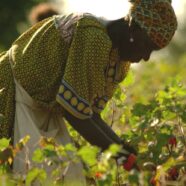
African cotton is almost exclusively grown by smallholder farmers using traditional crop rotation methods, irrigating their fields with harvested rainwater and picking cotton by hand. It accounted for 8% of world cotton in 2008-9, placing Africa outside the world’s top ten cotton producers and well behind major producers such as China (32%) and India (22%). Sustainable cotton represents just 2% of the world’s fibre, with sustainable African cotton currently comprising a tiny fraction of the total.
However, a new partnership between the Better Cotton Initiative (BCI) and Cotton Made in Africa (CMiA), a not-for-profit initiative founded by the Aid by Trade Foundation (AbTF), plans to change this and help mainstream sustainable African cotton, for good.
The new accord, signed in Paris in August 2013, will see BCI and CMiA collaborating to increase sales while investing in improving the livelihoods of one million smallholder farmers by 2015 and five million by 2020. Progress will be reported annually via BCI’s Harvest Report. Importantly, the BCI and CMiA production standards have been aligned to create one major sustainable cotton standard in Africa. This means cotton produced via either initiative can be traded under the same banner of ‘Better Cotton’.
With the African population set to quadruple over the next 90 years, according to the World Bank, laying the foundations for a growing sustainable cotton movement in Africa could also create significant employment opportunities in the future.
Defining Better Cotton
Better Cotton is defined by a clear set of production principles and criteria spanning crop protection, irrigation, soil health, wildlife conservation, fibre quality and labour conditions. It is currently grown in Brazil, China, India, Pakistan, Turkey, Mali and Mozambique, with work also underway to grow Better Cotton in Senegal. BCI works with a diverse range of partners to promote measureable and continuous improvements.
Some 670,000 tonnes of Better Cotton were produced in 2012, supported by training programmes funded by BCI’s 239 global members, who comprise many of the world’s largest apparel and textile retailers and manufacturers (H&M and Adidas, for example) as well as not-for-profit groups such as the WWF.
“Our aim is for 30% of the world’s total cotton production to be Better Cotton by 2020,” says Paola Geremicca, Partnership Director, CEO, Better Cotton Initiative. “It’s an ambitious target, but we believe that through working with strategic partners such as the Aid by Trade Foundation, it can be achieved. Collaborations of this kind are the only viable route to mainstreaming sustainable cotton.”
So what will this mean in practice and how will farmers and brands benefit?
Training is all important
“Having aligned the BCI and CMiA production standards, we’re focusing on how we’ll work together to improve the livelihoods of African cotton farmers and workers,” says Geremicca. “This means tackling key social and environmental issues including child labour, integrated pest management and impact assessment.”
BCI already works with partners on the ground to train farmers and workers on its production criteria and core values, particularly around social standards. The range of topics covered depends on the cultural context of a country or region. In Mali, BCI provides leadership and communication training to female cotton farmers and workers to address gender equality issues in the community.
Any joint training initiatives instigated via the new BCI-CMiA accord will reinforce this tailored approach. Ultimately, through teaching safer and more cost effective farming methods, such as efficient management of insecticides and pesticides, BCI aims to help farmers boost their yields and profitability. And, says Geremicca, it’s important that no distinction is made between ‘Better Cotton farmers’ and ‘CmiA farmers’. It’s all about the bigger picture.
“We’re both committed to transforming the cotton sector and both initiatives are working to ensure sustainable cotton becomes a mainstream commodity, she says. “This starts with helping farmers to reduce their environmental footprint.”
Taking sustainable African cotton mainstream
“BCI creates supply and demand simultaneously, meaning smallholder farmers achieve improved market access by growing Better Cotton,” says Geremicca. “Our partnership with CMiA will continually help to reach more farmers. Additionally, as more members join BCI and commit to buying and using Better Cotton, demand will grow and farmers will be able to sell bigger volumes to an increasing number of ginners.”
Helping brands source Better Cotton
BCI is planning to increase the uptake of Better Cotton from Africa by making the sourcing process more streamlined. To this end, it has developed the Better Cotton Tracer, an online tool designed to help BCI members track Better Cotton procurement transactions across the supply chain and communicate with each other on best practice in sourcing Better Cotton.
“There will be an increased volume of Better Cotton available for BCI members to source from all over Africa,” says Geremicca. “All our members will be fully briefed on the agreement and its implications. For supplier and manufacturer members, we provide regular training to ensure they’re fully confident about how to procure Better Cotton, in Africa and around the world.”
On supporting Better Cotton versus other types of sustainable cotton, Geremicca is clear. BCI does not want to position Better Cotton as the only or best option: “We’re actively working with other prominent sustainability groups, governments and global standards to benchmark cotton across continents. Ultimately, we want to create a global standard and help sustainable cotton to become the norm, a truly mainstream commodity.”
This article was originally published on the Ethical Fashion Forum’s SOURCE Intelligence site.

